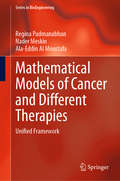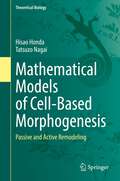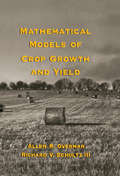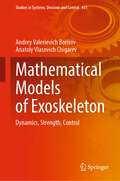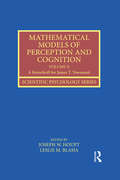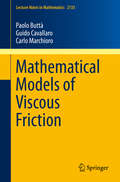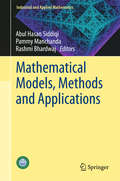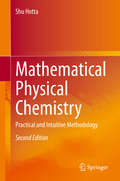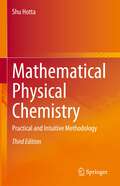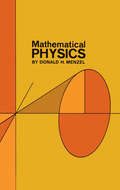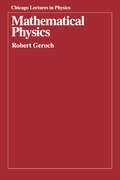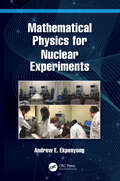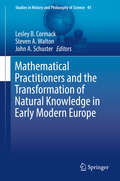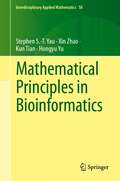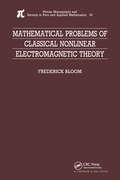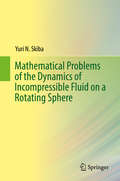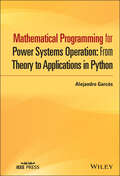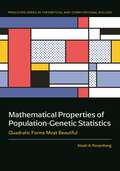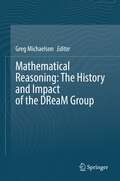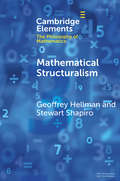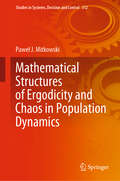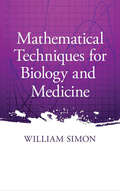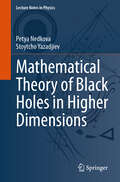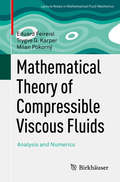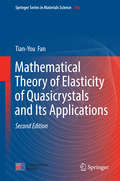- Table View
- List View
Mathematical Models of Cancer and Different Therapies: Unified Framework (Series in BioEngineering)
by Regina Padmanabhan Nader Meskin Ala-Eddin Al MoustafaThis book provides a unified framework for various currently available mathematical models that are used to analyze progression and regression in cancer development, and to predict its dynamics with respect to therapeutic interventions. Accurate and reliable model representations of cancer dynamics are milestones in the field of cancer research. Mathematical modeling approaches are becoming increasingly common in cancer research, as these quantitative approaches can help to validate hypotheses concerning cancer dynamics and thus elucidate the complexly interlaced mechanisms involved. Even though the related conceptual and technical information is growing at an exponential rate, the application of said information and realization of useful healthcare devices are lagging behind.In order to remedy this discrepancy, more interdisciplinary research works and course curricula need to be introduced in academic, industrial, and clinical organizations alike. To that end, this book reformulates most of the existing mathematical models as special cases of a general model, allowing readers to easily get an overall idea of cancer dynamics and its modeling. Moreover, the book will help bridge the gap between biologists and engineers, as it brings together cancer dynamics, the main steps involved in mathematical modeling, and control strategies developed for cancer management. This also allows readers in both medical and engineering fields to compare and contrast all the therapy-based models developed to date using a single source, and to identify unexplored research directions.
Mathematical Models of Cell-Based Morphogenesis: Passive and Active Remodeling (Theoretical Biology)
by Hisao Honda Tatsuzo NagaiThis book describes the shape formation of living organisms using mathematical models. Genes are deeply related to the shape of living organisms, and elucidation of a pathway of shape formation from genes is one of the fundamental problems in biology. Mathematical cell models are indispensable tools to elucidate this problem. The book introduces two mathematical cell models, the cell center model and the vertex model, with their applications. The cell center model is applied to elucidate the formation of neat cell arrangements in epidermis, cell patterns consisting of heterogeneous-sized cells, capillary networks, and the branching patterns of blood vessels. The vertex model is applied to elucidate the wound healing mechanisms of the epithelium and ordered pattern formation involving apoptosis. Pattern formation with differential cell adhesion is also described. The vertex model is then extended from a two-dimensional (2D) to a three-dimensional (3D) model. A cell aggregate involving a large cavity is described to explain the development of the mammalian blastocyst or the formation of an epithelial vesicle. Epithelial tissues and the polarity formation process of the epithelium are also explained. The vertex model also recapitulates active remodeling of tissues and describes the twisting of tissue that contributes to understanding the cardiac loop formation of the embryonic tube. The book showcases that mathematical cell models are indispensable tools to understand the shape formation of living organisms. Successful contribution of the mathematical cell models means that the remodeling of collective cells is self-construction. Examining the successive iterations of self-constructions leads to understanding the remarkable and mysterious morphogenesis that occurs during the development of living organisms. The intended readers of this book are not only theoretical or mathematical biologists, but also experimental and general biologists, including undergraduate and postgraduate students who are interested in the relationship between genes and morphogenesis.
Mathematical Models of Crop Growth and Yield (Books In Soils, Plants, And The Environment Ser. #Vol. 91)
by Allen R. Overman Richard V. Scholtz IIIHighlighting effective, analytical functions that have been found useful for the comparison of alternative management techniques to maximize water and nutrient resources, this reference describes the application of viable mathematical models in data analysis to increase crop growth and yields. Featuring solutions to various differential equations,
Mathematical Models of Exoskeleton: Dynamics, Strength, Control (Studies in Systems, Decision and Control #431)
by Andrey Valerievich Borisov Anatoly Vlasovich ChigarevThis book presents the current state of the problem of describing the musculoskeletal system of a person. Models of the destruction of the endoskeleton and the restoration of its functions using exoskeleton are presented. A description is given of new approaches to modeling based on the use of weightless rods of variable length with concentrated masses. The practical application to the tasks of numerical simulation of the movements of the musculoskeletal system of a person is described. Exoskeleton models with variable-length units based on absolutely hard sections and sections that change their telescopic type length have been developed.The book is intended for specialists in the field of theoretical mechanics, biomechanics, robotics and related fields. The book will be useful to teachers, as well as graduate students, undergraduates and senior students of higher educational institutions, whose research interests lie in the modeling of anthropomorphic biomechanical systems.
Mathematical Models of Perception and Cognition Volume II: A Festschrift for James T. Townsend (Scientific Psychology Series #2)
by Joseph W. Houpt Leslie M. BlahaIn this two volume festschrift, contributors explore the theoretical developments (Volume I) and applications (Volume II) in traditional cognitive psychology domains, and model other areas of human performance that benefit from rigorous mathematical approaches. It brings together former classmates, students and colleagues of Dr. James T. Townsend, a pioneering researcher in the field since the early 1960s, to provide a current overview of mathematical modeling in psychology. Townsend’s research critically emphasized a need for rigor in the practice of cognitive modeling, and for providing mathematical definition and structure to ill-defined psychological topics. The research captured demonstrates how the interplay of theory and application, bridged by rigorous mathematics, can move cognitive modeling forward.
Mathematical Models of Viscous Friction
by Paolo Buttà Guido Cavallaro Carlo MarchioroIn this monograph we present a review of a number of recent results on the motion of a classical body immersed in an infinitely extended medium and subjected to the action of an external force. We investigate this topic in the framework of mathematical physics by focusing mainly on the class of purely Hamiltonian systems, for which very few results are available. We discuss two cases: when the medium is a gas and when it is a fluid. In the first case, the aim is to obtain microscopic models of viscous friction. In the second, we seek to underline some non-trivial features of the motion. Far from giving a general survey on the subject, which is very rich and complex from both a phenomenological and theoretical point of view, we focus on some fairly simple models that can be studied rigorously, thus providing a first step towards a mathematical description of viscous friction. In some cases, we restrict ourselves to studying the problem at a heuristic level, or we present the main ideas, discussing only some aspects of the proof if it is prohibitively technical. This book is principally addressed to researchers or PhD students who are interested in this or related fields of mathematical physics.
Mathematical Models, Methods and Applications
by Abul Hasan Siddiqi Pammy Manchanda Rashmi BhardwajThe present volume contains invited talks of 11th biennial conference on "Emerging Mathematical Methods, Models and Algorithms for Science and Technology". The main message of the book is that mathematics has a great potential to analyse and understand the challenging problems of nanotechnology, biotechnology, medical science, oil industry and financial technology. The book highlights all the features and main theme discussed in the conference. All contributing authors are eminent academicians, scientists, researchers and scholars in their respective fields, hailing from around the world.
Mathematical Physical Chemistry: Practical and Intuitive Methodology
by Shu HottaThe second edition of this book has been extensively revised so that readers can gain ready access to advanced topics of mathematical physics including the theory of analytic functions and continuous groups. This easy accessibility helps to create a deeper and clearer insight into mathematical physics, with emphasis on quantum mechanics and electromagnetism along with the theory of linear vector spaces and group theory. The basic nature of the book remains unchanged. The contents are targeted at graduate and undergraduate students majoring in chemistry to supply them with the practical and intuitive methodology of mathematical physics. In parallel, advanced mathematical topics are dealt with in the last chapters of each of the four individual parts so that a close connection among those topics is highlighted. Several important revisions are found in this second edition, however, and they include: (a) a description of set theory and topology that helps to comprehend the essence of the theory of analytic functions and continuous groups; (b) a deep connection between angular momenta and continuous groups; (c) development of the theory of exponential functions of matrices, which is useful to solve differential equations; and (d) updated content on lasers and their applications. This new edition thus provides a balanced selection of new and basic material for chemists and physicists.
Mathematical Physical Chemistry: Practical and Intuitive Methodology
by Shu HottaThe third edition of this book has been updated so that both advanced physics and advanced chemistry can be overviewed from a modern mathematical perspective in a single integrated book. Nowadays key research arears in physics and chemistry such as materials science, molecular science, and device physics are drawing closer and closer together and becoming more and more mathematical. Hence, while retaining the basic feature, the contents are targeted at graduate and undergraduate students majoring in not only chemistry but also physics and engineering. The book covers topics ranging from classical physics (e.g., electromagnetism and analytical mechanics) to quantum science. The latter topic includes an introduction to the quantum theory of fields as well as standard quantum mechanics and quantum chemistry. Tangible examples help readers to understand abstract concepts about the topics covered. Several major revisions have been made and they contain: (a) constitution of the Dirac equation; (b) quantization of the fields; (c) interaction between the quantum fields; (d) basic formalism related to the extended vector spaces and the transformation properties of the Dirac equation; (e) advanced topics of Lie algebra. The new edition thus supplies chemists, physicists, and engineers with fundamental knowledge and calculation methodology of mathematical physics.
Mathematical Physics
by Donald H. MenzelThis is a thorough treatment in one volume of the mathematical techniques vital in classical mechanics, electromagnetic theory, quantum theory, and relativity. Designed for junior, senior, and graduate courses in mathematical physics, it presents full explanations of function theory, vectors, matrices, dyadics, tensors, partial differential equations, and other advanced mathematical techniques in their logical order during the presentation of the various physical theories. The completeness of the derivations makes the book especially useful for self-study.Several topics seldom presented, such as electron theory and relativity, appear in considerable detail, because an understanding of them is increasingly vital to the student of atomic physics. But the author's treatment of his chosen subjects in classical physics is no way slighted, and his book has proved valuable to students in all fields of physics.The opening section provides scores of definitions, conversion factors, dimensional constants, and electromagnetic quantities for ready reference later on. There follows a full treatment of the main branches of classical physics: potential theory, spherical harmonics, vector analysis, dyadics, matrices, tensors, hydrodynamics, advanced dynamics, waves and vibrations, quantum mechanics, electromagnetic theory, and radiation theory. The book concludes with a discussion from first principles of the theory of relativity.Nearly 200 problems ranging over a wide level of difficulty and selected from many different fields of physics are included, with answers, at ends of chapters. "The treatment is more detailed than normal for an advanced text . . . excellent set of sections on Dyadics, Matrices, and Tensors. . . . The part on waves and vibrations is well done . . . problems well varied in difficulty." - Journal of the Franklin Institute.
Mathematical Physics (Chicago Lectures in Physics)
by Robert GerochMathematical Physics is an introduction to such basic mathematical structures as groups, vector spaces, topological spaces, measure spaces, and Hilbert space. Geroch uses category theory to emphasize both the interrelationships among different structures and the unity of mathematics. Perhaps the most valuable feature of the book is the illuminating intuitive discussion of the "whys" of proofs and of axioms and definitions. This book, based on Geroch's University of Chicago course, will be especially helpful to those working in theoretical physics, including such areas as relativity, particle physics, and astrophysics.
Mathematical Physics for Nuclear Experiments
by Andrew E. EkpenyongMathematical Physics for Nuclear Experiments presents an accessible introduction to the mathematical derivations of key equations used in describing and analysing results of typical nuclear physics experiments. Instead of merely showing results and citing texts, crucial equations in nuclear physics such as the Bohr’s classical formula, Bethe’s quantum mechanical formula for energy loss, Poisson, Gaussian and Maxwellian distributions for radioactive decay, and the Fermi function for beta spectrum analysis, among many more, are presented with the mathematical bases of their derivation and with their physical utility. This approach provides readers with a greater connection between the theoretical and experimental sides of nuclear physics. The book also presents connections between well-established results and ongoing research. It also contains figures and tables showing results from the author’s experiments and those of his students to demonstrate experimental outcomes. This is a valuable guide for advanced undergraduates and early graduates studying nuclear instruments and methods, medical and health physics courses as well as experimental particle physics courses. Key features Contains over 500 equations connecting theory with experiments. Presents over 80 examples showing physical intuition and illustrating concepts. Includes 80 exercises, with solutions, showing applications in nuclear and medical physics.
Mathematical Practitioners and the Transformation of Natural Knowledge in Early Modern Europe
by Lesley B. Cormack Steven A. Walton John A. SchusterThis book argues that we can only understand transformations of nature studies in the Scientific Revolution if we take seriously the interaction between practitioners (those who know by doing) and scholars (those who know by thinking). These are not in opposition, however. Theory and practice are end points on a continuum, with some participants interested only in the practical, others only in the theoretical, and most in the murky intellectual world in between. It is this borderland where influence, appropriation, and collaboration have the potential to lead to new methods, new subjects of enquiry, and new social structures of natural philosophy and science. The case for connection between theory and practice can be most persuasively drawn in the area of mathematics, which is the focus of this book. Practical mathematics was a growing field in early modern Europe and these essays are organised into three parts which contribute to the debate about the role of mathematical practice in the Scientific Revolution. First, they demonstrate the variability of the identity of practical mathematicians, and of the practices involved in their activities in early modern Europe. Second, readers are invited to consider what practical mathematics looked like and that although practical mathematical knowledge was transmitted and circulated in a wide variety of ways, participants were able to recognize them all as practical mathematics. Third, the authors show how differences and nuances in practical mathematics typically depended on the different contexts in which it was practiced: social, cultural, political, and economic particularities matter. Historians of science, especially those interested in the Scientific Revolution period and the history of mathematics will find this book and its ground-breaking approach of particular interest.
Mathematical Principles in Bioinformatics (Interdisciplinary Applied Mathematics #58)
by Xin Zhao Hongyu Yu Kun Tian Stephen S.-T. YauThis textbook introduces bioinformatics to students in mathematics with no biology background assumed and it provides solid mathematical tools for biology students along with an understanding of how to implement them in bioinformatics problems. In addition to the basics, the text offers new approaches to understanding biological sequences. The concise presentation distinguishes itself from others on the subject, discussing and providing principles that relate to current open problems in bioinformatics as well as considering a variety of models. The convex hull principle is highlighted, opening a new interdisciplinary research area at the intersection of biology, mathematics, and computer science. Prerequisites include first courses in linear algebra, probability and statistics, and mathematical analysis. Researchers in mathematics, biology, and math-biology, will also find aspects of this text useful. This textbook is written based on the authors' research works that have been published in various journals along with the lecture notes used when teaching bioinformatics courses at the University of Illinois at Chicago and at Tsinghua University. The content may be divided into two parts. The first part includes three chapters, introducing some basic concepts. Chapter 1 provides biological background in molecular biology for mathematicians. Chapter 2 describes biological databases that are commonly used. Chapter 3 is concerned with alignment methods including global/local alignment, heuristic alignment, and multiple alignment. The second part consisting of five chapters, describes several bioinformatics principles using a rigorous mathematical formulation. Chapter 4 introduces the time-frequency spectral principle and its applications in bioinformatics. In Chapters 5 and 6, two strategies are used, the graphical representation and the natural vector method, to represent biological sequences, and conduct sequence comparison and phylogenetic analysis without alignment. Chapter 7 presents the convex hull principle and shows how it can be used to mathematically determine whether a certain amino acid sequence can be a protein. The last chapter summarizes additional mathematical ideas relating to sequence comparisons, such as new feature vectors and metrics. This part focuses on the governing principle in biology and provides plenty of alignment-free methods, which cannot be found in any other book.
Mathematical Problems of Classical Nonlinear Electromagnetic Theory (Monographs And Surveys In Pure And Applied Mathematics Ser. #Vol. 63)
by Frederick BloomA survey of some problems of current interest in the realm of classical nonlinear electromagnetic theory.
Mathematical Problems of the Dynamics of Incompressible Fluid on a Rotating Sphere
by Yuri N. SkibaThis book presents selected mathematical problems involving the dynamics of a two-dimensional viscous and ideal incompressible fluid on a rotating sphere. In this case, the fluid motion is completely governed by the barotropic vorticity equation (BVE), and the viscosity term in the vorticity equation is taken in its general form, which contains the derivative of real degree of the spherical Laplace operator.This work builds a bridge between basic concepts and concrete outcomes by pursuing a rich combination of theoretical, analytical and numerical approaches, and is recommended for specialists developing mathematical methods for application to problems in physics, hydrodynamics, meteorology and geophysics, as well for upper undergraduate or graduate students in the areas of dynamics of incompressible fluid on a rotating sphere, theory of functions on a sphere, and flow stability.
Mathematical Programming for Power Systems Operation: From Theory to Applications in Python (IEEE Press)
by Alejandro Garcés RuizExplore the theoretical foundations and real-world power system applications of convex programming In Mathematical Programming for Power System Operation with Applications in Python, Professor Alejandro Garces delivers a comprehensive overview of power system operations models with a focus on convex optimization models and their implementation in Python. Divided into two parts, the book begins with a theoretical analysis of convex optimization models before moving on to related applications in power systems operations. The author eschews concepts of topology and functional analysis found in more mathematically oriented books in favor of a more natural approach. Using this perspective, he presents recent applications of convex optimization in power system operations problems. Mathematical Programming for Power System Operation with Applications in Python uses Python and CVXPY as tools to solve power system optimization problems and includes models that can be solved with the presented framework. The book also includes: A thorough introduction to power system operation, including economic and environmental dispatch, optimal power flow, and hosting capacity Comprehensive explorations of the mathematical background of power system operation, including quadratic forms and norms and the basic theory of optimization Practical discussions of convex functions and convex sets, including affine and linear spaces, politopes, balls, and ellipsoids In-depth examinations of convex optimization, including global optimums, and first and second order conditions Perfect for undergraduate students with some knowledge in power systems analysis, generation, or distribution, Mathematical Programming for Power System Operation with Applications in Python is also an ideal resource for graduate students and engineers practicing in the area of power system optimization.
Mathematical Properties of Population-Genetic Statistics: Quadratic Forms Most Beautiful (Princeton Series in Theoretical and Computational Biology)
by Noah A. RosenbergA powerful new approach to interpreting population-genetic data in evolution and ecologyPopulation genetics uses statistical analysis to catalog genetic variation among populations and species. Summary statistics computed from allele frequencies—mathematical functions that measure features of genetic similarity and diversity—are key to this global effort. Yet despite their widespread use in evolutionary biology, ecology, and conservation biology, their mathematical properties have largely been overlooked. This book shows how to use the mathematical bounds on summary statistics to make better interpretations of population-genetic data.Noah Rosenberg discusses how the behavior of these statistics depends not only on the biology of the populations they seek to describe but also on the mathematical properties of the functions used to compute them, properties that produce constraints on the values of the statistics and influence their interpretation. Focusing on the concept of homozygosity—a quadratic function of allele frequencies in a population—he demonstrates how to account for mathematical constraints when measuring genetic similarity and diversity. Rosenberg illustrates the results using examples from empirical data and shares strategies that readers can use to apply this mathematical perspective to different kinds of summary statistics, including those for measuring biodiversity in ecological communities.Drawing inspiration from Charles Darwin, who marveled at evolution&’s &“endless forms most beautiful and most wonderful,&” this book presents a groundbreaking approach to the study of genetic variation. It is sure to stimulate new research in population biology and deeper thinking about the meaning and interpretation of essential measurements of the world&’s genomes.
Mathematical Reasoning: The History and Impact of the DReaM Group
by Greg MichaelsonThis collection of essays examines the key achievements and likely developments in the area of automated reasoning. In keeping with the group ethos, Automated Reasoning is interpreted liberally, spanning underpinning theory, tools for reasoning, argumentation, explanation, computational creativity, and pedagogy. Wider applications including secure and trustworthy software, and health care and emergency management. The book starts with a technically oriented history of the Edinburgh Automated Reasoning Group, written by Alan Bundy, which is followed by chapters from leading researchers associated with the group. Mathematical Reasoning: The History and Impact of the DReaM Group will attract considerable interest from researchers and practitioners of Automated Reasoning, including postgraduates. It should also be of interest to those researching the history of AI.
Mathematical Structuralism (Elements in the Philosophy of Mathematics)
by Geoffrey Hellman Stewart ShapiroThe present work is a systematic study of five frameworks or perspectives articulating mathematical structuralism, whose core idea is that mathematics is concerned primarily with interrelations in abstraction from the nature of objects. The first two, set-theoretic and category-theoretic, arose within mathematics itself. After exposing a number of problems, the book considers three further perspectives formulated by logicians and philosophers of mathematics: sui generis, treating structures as abstract universals, modal, eliminating structures as objects in favor of freely entertained logical possibilities, and finally, modal-set-theoretic, a sort of synthesis of the set-theoretic and modal perspectives.
Mathematical Structures of Ergodicity and Chaos in Population Dynamics (Studies in Systems, Decision and Control #312)
by Paweł J. MitkowskiThis book concerns issues related to biomathematics, medicine, or cybernetics as practiced by engineers. Considered population dynamics models are still in the interest of researchers, and even this interest is increasing, especially now in the time of SARS-CoV-2 coronavirus pandemic, when models are intensively studied in order to help predict its behaviour within human population. The structures of population dynamics models and practical methods of finding their solutions are discussed. Finally, the hypothesis of the existence of non-trivial ergodic properties of the model of erythropoietic response dynamics formulated by A. Lasota in the form of delay differential equation with unimodal feedback is analysed. The research can be compared with actual medical data, as well as shows that the structures of population models can reflect the dynamic structures of reality.
Mathematical Techniques for Biology and Medicine
by William SimonThis pioneering book was one of the first to describe the use of advanced mathematical methods in the life sciences. Used widely in one-semester courses, it assumes only elementary calculus and proceeds rapidly, but in a complete and self-contained way, through techniques essential to medicine and biology. Some techniques are unique to this volume and others emphasize the chemical and physical principles underlying biological processes. Less emphasis is given to formal solutions than to methods designed to develop physical intuition and to numerical solutions.Full chapters are devoted to compartmental problems, regulation and oscillation of feedback control systems, numerical methods, diffusion processes, blood flow measurements, curve fitting, and the use of tracers. Unlike most mathematical texts, this book avoids engineering terminology since it is often unfamiliar to biologists. A problem section is included at the end of each chapter, with problems ranging from relatively simple to fairly challenging. Fully worked-out solutions are included for some of the problems. This new fourth edition includes an updated preface and an appendix with sample programs.
Mathematical Theory of Black Holes in Higher Dimensions (Lecture Notes in Physics #1031)
by Petya Nedkova Stoytcho YazadjievThis book portraits the mathematical theory which lies behind black hole solutions in spacetimes with an extra dimension. Step by step the authors build a comprehensive picture of the main concepts and tools necessary to understand these geometries. In this way the book addresses questions like: How do we describe black holes in higher dimensions? How can we construct such geometries explicitly as exact solutions to the field equations? How many independent solutions can exist and how are they classified?The book concentrates on five-dimensional stationary and axisymmetric spacetimes in electro-vacuum and systematically introduces the most important black geometries which can arise in these settings. The authors follow the natural progress of the research area by initially describing the first results that were obtained intuitively and sparkled interest in the community. Then the elaborate mathematical techniques are introduced which allow to systematically construct exact black hole solutions. Topics like the integrability of the theory, the hidden symmetries of the field equations, the available Bäcklund transformations and solution generation techniques based on the inverse scattering method are covered. The last part of the book is devoted to uniqueness theorems showing how to classify the black hole spacetimes and distinguish the non-equivalent ones.The book is not just a mere collection of facts but a methodological description of the most important mathematical techniques and constructions in an active research area. The discussion is pedagogical and all the methods are demonstrated on a variety of examples. Most of the book is adapted to the level of a graduate student possessing a basic knowledge of general relativity and differential equations, and can serve as a practical guide for quickly acquiring the specific concepts and calculation techniques. Both authors have contributed to the research area by their original results, and share their own experience and perspective.
Mathematical Theory of Compressible Viscous Fluids
by Eduard Feireisl Trygve G. Karper Milan PokornýThis book offers an essential introduction to the mathematical theory of compressible viscous fluids. The main goal is to present analytical methods from the perspective of their numerical applications. Accordingly, we introduce the principal theoretical tools needed to handle well-posedness of the underlying Navier-Stokes system, study the problems of sequential stability, and, lastly, construct solutions by means of an implicit numerical scheme. Offering a unique contribution - by exploring in detail the "synergy" of analytical and numerical methods - the book offers a valuable resource for graduate students in mathematics and researchers working in mathematical fluid mechanics. Mathematical fluid mechanics concerns problems that are closely connected to real-world applications and is also an important part of the theory of partial differential equations and numerical analysis in general. This book highlights the fact that numerical and mathematical analysis are not two separate fields of mathematics. It will help graduate students and researchers to not only better understand problems in mathematical compressible fluid mechanics but also to learn something from the field of mathematical and numerical analysis and to see the connections between the two worlds. Potential readers should possess a good command of the basic tools of functional analysis and partial differential equations including the function spaces of Sobolev type.
Mathematical Theory of Elasticity of Quasicrystals and Its Applications
by Tian-You FanThis interdisciplinary work on condensed matter physics, the continuum mechanics of novel materials, and partial differential equations, discusses the mathematical theory of elasticity and hydrodynamics of quasicrystals, as well as its applications. By establishing new partial differential equations of higher order and their solutions under complicated boundary value and initial value conditions, the theories developed here dramatically simplify the solution of complex elasticity problems. Comprehensive and detailed mathematical derivations guide readers through the work. By combining theoretical analysis and experimental data, mathematical studies and practical applications, readers will gain a systematic, comprehensive and in-depth understanding of condensed matter physics, new continuum mechanics and applied mathematics. This new edition covers the latest developments in quasicrystal studies. In particular, it pays special attention to the hydrodynamics, soft-matter quasicrystals, and the Poisson bracket method and its application in deriving hydrodynamic equations. These new sections make the book an even more useful and comprehensive reference guide for researchers working in Condensed Matter Physics, Chemistry and Materials Science.
